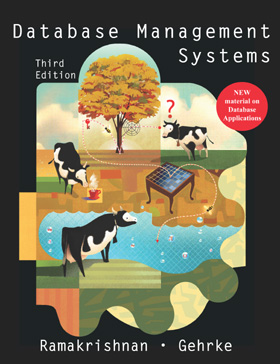
Second Edition

This book covers the fundamentals of modern database management systems, in
particular relational database systems. It is intended as a text that can be used in
an introductory database course for undergraduates, and in a second database
course at the undergraduate and graduate levels. Basic concepts and widely-used,
industry-standard techniques are emphasized. Up-to-date coverage in the second
edition includes
chapters on physical database design and tuning, internet databases, decision
support, data mining, object-databases, spatial data management, and deductive
databases. The second edition was available from 1999-2002.
Here is the
material for the current edition.
Material for the Second Edition

New in the Second Edition
Based on extensive user surveys and feedback, we have refined the
book's organization. The major change is the early introduction of
the ER model, together with a discussion of conceptual database
design. As in the first edition, we introduce SQL-92's data
definition features together with the relational model (in Chapter 3),
and whenever appropriate, relational model concepts (e.g., definition
of a relation, updates, views, ER to relational mapping) are
illustrated and discussed in the context of SQL. Of course, we
maintain a careful separation between the concepts and their SQL
realization. The material on data storage, file organization, and
indexes has been moved back, and the material on relational queries
has been moved forward. Nonetheless, the two parts (storage and
organization vs.~queries) can still be taught in either order based on
the instructor's preferences.
In order to facilitate brief coverage in a first course, the second
edition contains overview chapters on transaction processing and query
optimization. Most chapters have been revised extensively, and
additional explanations and figures have been added in many places.
For example, the chapters on query languages now contain a uniform
numbering of all queries to facilitate comparisons of the same query
(in algebra, calculus, and SQL), and the results of several queries
are shown in figures. JDBC and ODBC coverage has been added to the
SQL query chapter and SQL:1999 features are discussed both in this
chapter and the chapter on object-relational databases. A discussion
of RAID has been added to Chapter 7. We have added a
new database design case study, illustrating the entire design cycle,
as an appendix.
Two new pedagogical features have been introduced. First, `floating
boxes' provide additional perspective and relate the concepts to real
systems, while keeping the main discussion free of product-specific
details. Second, each chapter concludes with a `Points to Review'
section that summarizes the main ideas introduced in the chapter and
includes pointers to the sections where they are discussed.
For use in a second course, many advanced chapters from the first
edition have been extended or split into multiple chapters to provide
thorough coverage of current topics. In particular, new material has
been added to the chapters on decision support, deductive databases,
and object databases.
New chapters on Internet databases, data
mining, and spatial databases have been added, greatly expanding the
coverage of these topics.

If you have further questions, or if you are using the book and
have found bugs or typos, or if you have any comments or suggestions
about the presentation or content, please contact Raghu Ramakrishnan or
Johannes Gehrke via email.
Raghu
Ramakrishnan and
Johannes Gehrke ,
August 1999.

|

![]()